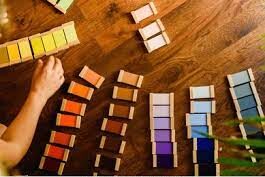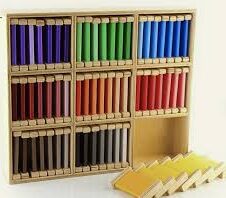Montessori Color Tablets are a fixed of educational gear used in Montessori school rooms to assist children expand color reputation and visual discrimination capabilities. These drugs are available diverse sunglasses and are generally divided into sets based on primary, secondary, and tertiary colors. Through fingers-on activities, youngsters discover ways to become aware of, suit, and grade hues, fostering each cognitive improvement and aesthetic appreciation. The Montessori Color Tablets provide a tactile and visual mastering experience, making abstract ideas more concrete for young beginners.
THE Montessori Color Tablets
MATERIAL :
Wooden tablets, all the same size and the same size and shape, with end bars long enough for holding the tablets without touching the colored part of the tablet.
Box 1
The wooden box pairs of the primary colors; 2red, 2 yellow, 2 blue tablets.
BOX 2
contains 22 tablets, representing the full color range, with pairs of each of the following colors: red, blue, yellow ,orange, green, pink, gray, brown, black, and white.
BOX 3
A box with 9 partitions holding 7 tablets in shades of one color. Seven shades of each of the following : crimson red, scarlet red (both shading to pink), blue, yellow, purpose, green, orange, brown, and gray. There is only a slight difference between any two shades in succession in order to educate the eyes to see very slight variations of hue.
The Montessori Color Tablets used must not be crude or too bright. It is important to give the children the most beautiful example of color. If possible, wind the tablets with embroidery silks. Silk takes the dye to produce the most beautiful colors. Children appreciate the beauty of these colors and the aesthetic sense is awakened. Children will also enjoy the smooth texture of the silk.

PURPOSE:
- To give the full color range
- To make the child aware of color and lead him to observe the environment with intelligence
- To help the child to appreciate beauty
- To prepare the child for artwork
AGE:
2 and ⅕ years on words
PRESENTATION:
Children’s Montessori Color Tablets should be of neutral coloring for least distraction. The teacher takes Box 1 to the child’s table. She sits beside the child and takes the tablets out of the box, holding them by their wooden ends. She lays them in mixed order, but parallel to each other, in front of the child on the tablets (instead of to the right and left).
PREPARATION:
The teacher gives the child a lesson in holding the tablets without touching the colored part. She picks a tablet up carefully by the wooden end and says, “LOOK, I can hold this tablet like this, and I do not touch the beautiful color. look , i can hold this one too. Show me if you can hold this one without touching the color.”
BOX 1 :
The child practices a little with the teacher, and then the teacher shows him how to pair the colors. She picks up any tablet, places it in front of him, and asks him to find another that is the same. (The names of the colors are not used at this point, as the child may not know the names of the colors.) If the child selects the correct tablet, the teacher looks at the two tablets saying, “Yes, these are the same. We will put them together. “
She places them toward the top of the table. She puts another tablet in front of the child and asks him to find the matching one. When he does so, the two are put side by side. “Yes, these are the same so we will put them together. “ The second pair is placed under the first. The third pair is placed under the second pair.
If the child hands the wrong color at any point, the teacher would not accept it. She would lay the two side by side, consider them and say, “No, these are not the same. Find one just the same as this one,” ( She puts the one she first of the child). When the child understands the exercise, he can work alone.
BOX 2 :
When the child can do box 1 easily, half of Box 2 may be given. (Some children can manage the whole box). The exercise is the same, so the normal child should not need another lesson. When he can pair these six colors easily, the teacher can give him all 11 pairs to work with.
BOX 3 :
The teacher takes the box to the child’s table and sits beside him, taking out seven shades of one color and laying them in mixed order on the table in front of him. The teacher asks the child to find the darkest shade. The teacher puts this to the left and asks him to find the darkest of those remaining. The teacher puts this next to the first, and so on, so that seven shades are arranged from dark to light in a ribbon of color. Some help may have to be given as this exercise is very difficult.
The teacher takes out another group of seven shades of color and helps the child to arrange them from dark to light under the first color. The teacher continues to give help until the child understands the exercise and can work alone.
NOTE: the teacher does not correct the child if he makes mistakes when working alone. No one can teach another to see color. By working with the material, the child perfect himself. This is especially true when working with Color Box 3. Never mix all the colors in box 3. Only mix shades of one color.
VOCABULARY
For Boxes 1 and 2 – The names of the colors For Box 3: Lighter – Dark
Light – Lighter – Lightest
Dark – Darker – Darkest
Conclusion,
Montessori Color Tablets are important instructional equipment that assist the development of coloration reputation and visible discrimination in children. These tablets, prepared into units primarily based on primary, secondary, and tertiary colors, provide a arms-on, tactile getting to know enjoy. Through based activities, youngsters discover ways to perceive, suit, and grade shades, enhancing each cognitive capabilities and aesthetic appreciation. The materials used, which includes beautifully dyed silk, emphasize exceptional and splendor, similarly enriching the kid’s mastering experience. Suitable for children elderly 2.Five years and older, these sporting activities prepare them for greater complicated duties, fostering a deep cognizance and appreciation of color of their surroundings.
